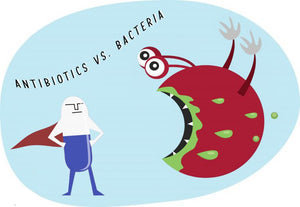Antibiotics Resistance in the News
May 01, 2018

Today’s headlines are filled with stories about antibiotic resistance, a state where antibiotics no longer kill dangerous bacteria.
Recent headlines in the British daily newspaper, The Telegraph, announced that tourism is spreading antibiotic-resistant superbugs. The article discusses a study in which researchers found that people who had traveled to South America, the Middle East, or certain other areas of the world are more likely to carry superbugs.
The Washington Post headline “’Our greatest fear’: Highly drug-resistant gonorrhea confirmed by health officials” is quite alarming. That newspaper article details a case report of a man who developed an antibiotic-resistant strain of the very common sexually transmitted disease. Doctors prescribed the two most commonly used antibiotics for the treatment of gonorrhea, azithromycin and ceftriaxone, but tests still came back positive for the infection; the doctors hope that using a “last resort” antibiotic, ertapenem, will treat the infection.
The problem is that certain strains of bacteria are very smart. A representative of the World Health Organization (WHO) said, “…every time we use a new class of antibiotics to treat the infection, the bacteria evolve to resist them.”
Antibiotic resistance is getting worse in ways that even scientists could never predict – antibiotic resistance is now appearing in animals. Food producers have been administering antibiotics to farm animals to protect the livestock from infectious diseases, boost growth, and maximize profits. While effective for marketing, the widespread administration of antibiotics to healthy livestock has caused antibiotic resistance to spread to the animal kingdom.
What Other Headlines Say
The online magazine Futurism discusses how bacteria around the world are sharing a gene that makes the microorganisms resistant to colistin, another “last resort” antibiotic used when all others fail. In humans, colistin can cause kidney problems so it is used sparingly. The drug is widely used in agriculture to protect and fatten up livestock, though, especially in China.
Researchers in one study had discovered that the gene responsible for drug resistance to the bacteria S. flexneri, a primary cause of potentially fatal diarrhea, was spreading among pigs on Chinese farms. Another research team later found this gene on a transferable plasmid, which is a genetic element that can jump from one bacterial species to another and carry drug resistance with it. In that case, antibiotic resistance jumped from S. flexneri to E. coli, making both bacteria resistant to colistin.
The online magazine Down to Earth recently published a story entitled “We can no longer outrun antibiotic resistance. So, here’s what we need to do instead.” The article describes how bacteria are becoming resistant to antibiotics faster than humans can develop new antibiotics. This poses a substantial public health crisis, as infections that were easy to treat during the 20th century have become increasingly deadly.
The magazine called the battle to stay ahead of antibiotic resistance an “arms race” in which humans are rarely ahead of the microbes. Antibiotics are chemicals that kill or slow the growth of bacteria. While most people think you can only get antibiotics in a bottle, organisms in the environment actually produce natural antibiotics to protect themselves from harmful pathogens. In fact, scientists have discovered many of today’s antibiotics in natural environments. Scientists first found the antibiotics penicillin in Penicillium notatum a type of mold, for example, and streptomycin in soil bacteria.
Just as bacteria can develop antibiotic chemicals to protect themselves, they can also develop resistance to antibiotics. Widespread use, particularly in healthy individuals, hastens the development of antibiotic resistance.
Thousands of lives are at stake in the arms race to develop antibiotics and reduce antibiotic resistance. More than 2 million people in the United States develop infections from antibiotic resistant bacteria each year, according to the Centers for Disease Control and Prevention (CDC), and at least 23,000 people die annually as the result of these infections. A microbiologist at McMaster University in Ontario, Canada, Gerry Wright says, “Each time we use an antibiotic, it creates the opportunity for that adapt-or-die dichotomy.”
Major cities across the U.S. are experiencing surges in resistant strains of C. difficile (C. diff) and Methicillin-resistant Staphylococcus Aureus (MRSA). These bacteria can live anywhere, including the local gym, steering wheels, supermarkets, and even iPhones and tablets. The bacteria are also common in hospitals, nursing homes, and other healthcare institutions.
Practical Tips for Everyday Survival
While the headlines practically warn of a Zombie Apocalypse when it comes to the spread of antibiotics resistance, it will not necessarily come to that as long as scientists, doctors, and consumers take sensible precautions.
An astounding 70 to 80 percent of immune system cells are in the intestines, which makes the gut the best place to wage war against antibiotic resistance. These immune cells protect the body from dangerous pathogens entering through the intestinal barrier.
Learn about any medications prescribed while traveling. Antibiotics are misused in many parts of the world, particularly in Asia.
Take probiotic supplements. Probiotics, which are beneficial bacteria, can help protect the body by crowding out harmful antibiotic-resistant bacteria. Daily probiotic supplementation keeps probiotic populations high.
Take charge of your own health. If your doctor prescribes antibiotics, ask about the reasons behind the prescription and discuss possible alternatives.
If you do take antibiotics, be sure to take the full course. Speak with a doctor about using probiotics to help restore any gut imbalances caused by antibiotic use. Take probiotics at least two hours before or after using antibiotics. Continue to use the probiotics after completing the antibiotics as research has shown one round of a standard antibiotic can change your gut flora for up to a year.
Stay up on any news regarding antibiotic resistance. The more you know about antibiotic resistance, the safer you and your family can be.
The post Antibiotics Resistance in the News appeared first on Natren Probiotics Blog.





Leave a comment